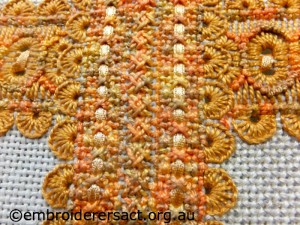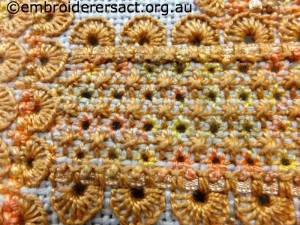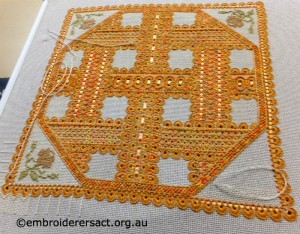I am an addict, and like so many addicts I promote temperance or outright abstention. But I AM an addict. This is why one evening I bought this on, I think, Amazon. Because I...must...OWN...IT!
Yes, this is a nice fresh scan of the chart that appears to have started it all. Like so many older charts, the analog photo isn't really very good at all even if it is enlarged substantially.
So let me give you some details from the charts inside. The model was stitched on tan canvas. If you take a little peek at the enlarged photo THROUGH the lacy band stitches, you will see tan. So where did the red come from? All that color is little multi-direction tent (aka 4-way continental) stitches in a floss to match your ribbon color. Again, enlarge the photo and you can see the pink ribbon.
Here is a scan of the inside front cover. I wanted you to see the designers' names, Carol Costello and Jinell Ibey. A quick google search shows some nice photos of designs attributed to either or both of them. In fact, you can still order some of Fancy Work & Fantasies designs here. As you can also see, this was published in 1980, fairly early in the counted thread revival in the late 20th century. Back then there was no graphic software available for designers so everything including the layout diagram was hand drawn. See kids, you DO use geometry after high school!
The design is divided into six separate ribbons comprising five separate little samplers (#4 and #6 are the same). Each stitched ribbon incorporates a length of colored satin ribbon that can coordinate with those tent stitches. All the ribbons are stitched with #5 and #8 pearl cotton in ecru on 14-count mono canvas. And it does have to be done on mono canvas, because you have some pulled work on this. Congress cloth is too closely woven for the fabric threads to displace well. Linen would be too soft as the stiff canvas is really what makes this pop. The basic stitches used are those tent stitches, various eyelets, smyrnas, and french knots over the tent stitches to make those corner roses.
So I have to say I really like this technique. Tanja Berlin took this idea and really ran with it, creating some fun pieces that introduced a whole lot of stitchers to an idea that came out of a couple of Southern California needleworkers in 1980. Google "Hapsburg Lace" and click on "images" for more fun pictures.
Now, how do you take a project from 1980 and modernize it up? Because 2015 - 1980 = styles have changed.
Here is a photo I found on an Australian website. Jan Hure is the name of the needleworker. You can see that she has combined an overdyed pearl cotton in the middle with a solid color for the edges. Nice. She changed out the rose colors and it look like she didn't use the tent stitch background.
Remember, click on a picture to enlarge it.

 You could use a brilliant varied overdye as the accent floss, or add some metallic thread as part of the ribbon design or even in place of the satin ribbon. Stitching it on 18-count with #8 and #12 pearl cotton (like Tanja does) would make it smaller and a bit more modern. Also, why stick with a rose in the corner if you could add a bug or a skull? Initials are always good too. Why do all the stitched ribbons have to be the same color?
You could use a brilliant varied overdye as the accent floss, or add some metallic thread as part of the ribbon design or even in place of the satin ribbon. Stitching it on 18-count with #8 and #12 pearl cotton (like Tanja does) would make it smaller and a bit more modern. Also, why stick with a rose in the corner if you could add a bug or a skull? Initials are always good too. Why do all the stitched ribbons have to be the same color?And for goodness sake, don't assume you have to finish the pillow like the chart's photo. Really, I promise you, it's okay.
Check out my EGA blog link above and see what Yvonne did to bump up her project. More photos of our chapter project will be added as I see more finished work.
Now, it's not likely that I'm going to actually stitch this guy. (Though to confess I DO happen to have some white 14-count canvas in my stash and some pearl cotton that would be just great for this. What a coincidence!) My addiction is often satisfied just by ownership of the pattern. I am like a dragon hoarding not gold but lots of paper covered with strange little runes.



Carol Costello intrroduced most of her books and patterns at The Enchanted Unicorn in Redlands, CA, when it was on State Street. I worked there then and I taught several of her Hapsburg designs. Carol's techniques are a little different from those of Tanja Berlin...eyelets and placement of French knots at the tip of the spokes. Both are beautiful variations.
ReplyDeleteOne more note....her second book that shows a pillow with a diagonal pattern is my favorite and beautiful when made up!
ReplyDeleteSubmit your blog or website now for inclusion in Google and 300+ search engines!
ReplyDeleteOver 200,000 sites handled!
Submit NOW with I Need Hits!